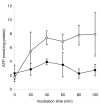Toxicity of unsaturated fatty acids to the biohydrogenating ruminal bacterium, Butyrivibrio fibrisolvens
- PMID: 20167098
- PMCID: PMC2836310
- DOI: 10.1186/1471-2180-10-52
Toxicity of unsaturated fatty acids to the biohydrogenating ruminal bacterium, Butyrivibrio fibrisolvens
Abstract
Background: Health-promoting polyunsaturated fatty acids (PUFA) are abundant in forages grazed by ruminants and in vegetable and fish oils used as dietary supplements, but only a small proportion of PUFA finds its way into meat and milk, because of biohydrogenation in the rumen. Butyrivibrio fibrisolvens plays a major role in this activity. The aim of this study was to investigate the mechanisms by which PUFA affect the growth of B. fibrisolvens, how PUFA are metabolized and the metabolic response to growth in the presence of PUFA.
Results: Linoleic acid (LA; cis-9, cis-12-18:2) and alpha-linolenic acid (LNA; cis-9, cis-12, cis-15-18:3) increased the lag phase of B. fibrisolvens JW11, LNA having the greater effect. Growth was initiated only when the PUFA had been converted to vaccenic acid (VA; trans-11-18:1). The major fish oil fatty acids, eicosapentaenoic acid (EPA; 20:5(n-3)) and docosahexaenoic acid (DHA; 22:6(n-3)), were not metabolized and prevented growth. Cellular integrity, as determined fluorimetrically by propidium iodide (PI) ingression, was affected as much by 18:1 fatty acids, including VA, as 18:2 fatty acids. The methyl esters of LNA, LA, EPA and DHA had no effect on growth or other measurements. The ATP pool decreased by 2/3 when LA was added to growing bacteria, whereas most acyl CoA pools decreased by >96%.
Conclusions: It was concluded that biohydrogenation occurs to enable B. fibrisolvens to survive the bacteriostatic effects of PUFA, and that the toxicity of PUFA is probably mediated via a metabolic effect rather than disruption of membrane integrity.
Figures






Similar articles
-
Metabolism of polyunsaturated fatty acids and their toxicity to the microflora of the rumen.Antonie Van Leeuwenhoek. 2007 May;91(4):303-14. doi: 10.1007/s10482-006-9118-2. Epub 2006 Oct 28. Antonie Van Leeuwenhoek. 2007. PMID: 17072533
-
Influence of fish oil on ruminal biohydrogenation of C18 unsaturated fatty acids.Br J Nutr. 2006 Jun;95(6):1199-211. doi: 10.1079/bjn20061783. Br J Nutr. 2006. PMID: 16768845
-
Increased expression of a molecular chaperone GroEL in response to unsaturated fatty acids by the biohydrogenating ruminal bacterium, Butyrivibrio fibrisolvens.FEMS Microbiol Lett. 2006 Sep;262(2):244-8. doi: 10.1111/j.1574-6968.2006.00399.x. FEMS Microbiol Lett. 2006. PMID: 16923082
-
Influence of yeast on rumen fermentation, growth performance and quality of products in ruminants: A review.Anim Nutr. 2021 Mar;7(1):31-41. doi: 10.1016/j.aninu.2020.10.005. Epub 2020 Dec 31. Anim Nutr. 2021. PMID: 33997329 Free PMC article. Review.
-
Review: Modulating ruminal lipid metabolism to improve the fatty acid composition of meat and milk. Challenges and opportunities.Animal. 2018 Dec;12(s2):s272-s281. doi: 10.1017/S1751731118001994. Epub 2018 Aug 24. Animal. 2018. PMID: 30139411 Review.
Cited by
-
Feeding Corn Silage or Grass Hay as Sole Dietary Forage Sources: Overall Mechanism of Forages Regulating Health-Promoting Fatty Acid Status in Milk of Dairy Cows.Foods. 2023 Jan 9;12(2):303. doi: 10.3390/foods12020303. Foods. 2023. PMID: 36673395 Free PMC article.
-
DHA content in milk and biohydrogenation pathway in rumen: a review.PeerJ. 2020 Dec 22;8:e10230. doi: 10.7717/peerj.10230. eCollection 2020. PeerJ. 2020. PMID: 33391862 Free PMC article.
-
Long-Term Effects of Dietary Supplementation with Olive Oil and Hydrogenated Vegetable Oil on the Rumen Microbiome of Dairy Cows.Microorganisms. 2021 May 22;9(6):1121. doi: 10.3390/microorganisms9061121. Microorganisms. 2021. PMID: 34067293 Free PMC article.
-
Towards an understanding of oleate hydratases and their application in industrial processes.Microb Cell Fact. 2022 Apr 9;21(1):58. doi: 10.1186/s12934-022-01777-6. Microb Cell Fact. 2022. PMID: 35397585 Free PMC article. Review.
-
Phytochemical analysis and insight into insecticidal and antifungal activities of Indian hawthorn leaf extract.Sci Rep. 2023 Oct 11;13(1):17194. doi: 10.1038/s41598-023-43749-9. Sci Rep. 2023. PMID: 37821483 Free PMC article.
References
-
- Menotti A, Kromhout D, Blackburn H, Fidanza F, Buzina R, Nissinen A. Food intake patterns and 25-year mortality from coronary heart disease: cross-cultural correlations in the Seven Countries Study. The Seven Countries Study Research Group. Eur J Epidemiol. 1999;15:507–515. doi: 10.1023/A:1007529206050. - DOI - PubMed
-
- Viviani R. Metabolism of long-chain fatty acids in the rumen. Adv Lipid Res. 1970;8:267–346. - PubMed
Publication types
MeSH terms
Substances
LinkOut - more resources
Full Text Sources
Research Materials
Miscellaneous

